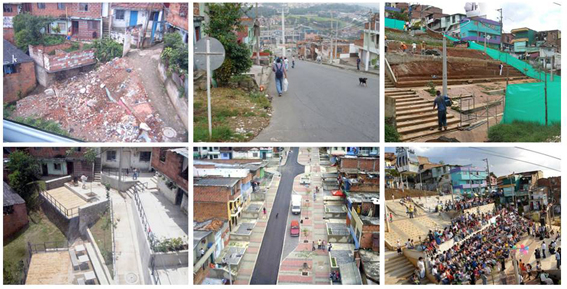Medellin: Difference between revisions
| Line 58: | Line 58: | ||
Illustration: Map/diagram/sketches photos and background notes | Illustration: Map/diagram/sketches photos and background notes | ||
=== Core Questions Working Group Public Space and Civic Identity === | |||
==== Who was involved in the participation process? ==== | |||
==== How was the participation process implemented (methods applied)? ==== | |||
==== In how far does/did the project respond to people's needs? ==== | |||
=== Analysis of program/function === | === Analysis of program/function === | ||
Revision as of 11:36, 7 December 2008
Social Urbanism: Enhancing community building and social capital through public space
Rationale: Why is this case study interesting?
The case study is related to a highly discussed issue present in many cities of the developing world today; it brings forward the importance of facing the challenges that slums create to today’s cities and the mechanisms used for tackling such challenge. The case study focuses on the use of Participatory Planning approaches in the context of slum upgrading. It is built around a case study in the city of Medellin, Colombia where there was a strong political will and commitment to implement programs and projects in the poorest areas of the city. This initiative emerged as a need to tackle deep rooted problems present in the slum areas of the city that together with other issues placed Medellin as the most dangerous city of the world during the 1990s.
For tackling such a problem, the local Administration (2003-2007) created a slum upgrading model called “PUI - Proyecto Urbano Integral” (Integral Urban Project) which is said to be based on “participatory planning” and “slum upgrading” principles. The creation of new public spaces was the most important action of the PUI. The results of the first project following the “PUI Model”, the “PUI Noriental”, have been promoted by the Administration as highly successful and been considered as a model for slum upgrading both nationally and internationally.
Author's perspective
- What theoretical or professional perspective do you bring to the case study?
Landscape and/or urban context
- Biogeography, cultural features, overall character, history and dynamics
Illustration: Map; sketches; short descriptive analyses
Cultural/social/political context
- Brief explanation of culture, political economy, legal framework
Illustration: Bullet points, image, background notes
History
- How did the area/project/plan at the focus of the case study evolve?
Illustration: Table or time line
Spatial analysis of area/project/plan
- What are the main structural features?
- How has it been shaped? Were there any critical decisions?
Illustration: Map/diagram/sketches photos and background notes
Core Questions Working Group Public Space and Civic Identity
Who was involved in the participation process?
How was the participation process implemented (methods applied)?
In how far does/did the project respond to people's needs?
Analysis of program/function
- What are the main functional characteristics?
- How have they been expressed or incorporated?
Illustration: Map/diagram/sketches photos and background notes
Analysis of design/planning process
- How was the area/project/plan formulated and implemented?
- Were there any important consultations/collaborations?
Illustration: Map/diagram/sketches photos and background notes
Analysis of use/users
- How is the area/project/plan used and by whom?
- Is the use changing? Are there any issues?
Illustration: Map/diagram/sketches photos and background notes
Future development directions
- How is the area/project/plan evolving?
- Are there any future goals?
Illustration: Map/diagram/sketches photos and background notes
Peer reviews or critique
- Has the area/ project/plan been reviewed by academic or professional reviewers?
- What were their main evaluations?
Pleas add references, quotes...
Points of success and limitations
- What do you see as the main points of success and limitations of the area/project/plan?
Illustration: Summary table
What can be generalized from this case study?
- Are there any important theoretical insights?
Short statement plus background notes
Which research questions does it generate?
Short statement plus background notes
Image Gallery
 "Talleres de Imaginarios por Proyecto" - Public Participation Workshops Source: EDU - Empresa de Desarrollo Urbano
"Talleres de Imaginarios por Proyecto" - Public Participation Workshops Source: EDU - Empresa de Desarrollo Urbano
 "Parque del Ajedrez, Paseo Andalucia and Parque de La paz y La Cultura" - before and after Source: Empresa de Desarrollo Urbano – EDU
"Parque del Ajedrez, Paseo Andalucia and Parque de La paz y La Cultura" - before and after Source: Empresa de Desarrollo Urbano – EDU
References
Please add literature, documentations and weblinks
About categories: You can add more categories by copying the tag and filling in your additional categories
